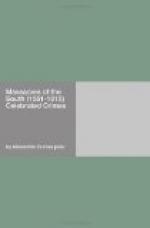Unfortunately for the cause of the king, though the rebels met with some resistance in the villages of the plain, such as St. Germain and St. Andre, it was otherwise with those situated in the mountains; in those, when beaten, the Protestants found cover, when victorious rest; so that M. de Montrevel becoming aware that while these villages existed heresy would never be extirpated, issued the following ordinance:—
“We, governor for His most Christian Majesty in the provinces of Languedoc and Vivarais, do hereby make known that it has pleased the king to command us to reduce all the places and parishes hereinafter named to such a condition that they can afford no assistance to the rebel troops; no inhabitants will therefore be allowed to remain in them. His Majesty, however, desiring to provide for the subsistence of the afore-mentioned inhabitants, orders them to conform to the following regulations. He enjoins on the afore-mentioned inhabitants of the hereinafter-mentioned parishes to repair instantly to the places hereinafter appointed, with their furniture, cattle, and in general all their movable effects, declaring that in case of disobedience their effects will be confiscated and taken away by the troops employed to demolish their houses. And it is hereby forbidden to any other commune to receive such rebels, under pain of having their houses also razed to the ground and their goods confiscated, and furthermore being regarded and treated as rebels to the commands of His Majesty.”
To this proclamation were appended the following instructions:—
“I. The officers who may be appointed to perform the above task shall first of all make themselves acquainted with the position of the parishes and villages which are to be destroyed and depopulated, in order to an effective disposition of the troops, who are to guard the militia engaged in the work of destruction.
“II. The attention of the officers is called to the following:—When two or more villages or hamlets are so near together that they may be protected at the same time by the same troops, then in order to save time the work is to be carried on simultaneously in such villages or hamlets.
“III. When inhabitants are found still remaining in any of the proscribed places, they are to be brought together, and a list made of them, as well as an inventory taken of their stock and corn.
“IV. Those inhabitants who are of the most consequence among them shall be selected to guide the others to the places assigned.
“V. With regard to the live stock, the persons who may be found in charge of it shall drive it to the appointed place, save and except mules and asses, which shall be employed in the transport of corn to whatever places it may be needed in. Nevertheless, asses may be given to the very old, and to women with child who may be unable to walk.
“VI. A regular distribution of the militia is to be made, so that each house to be destroyed may have a sufficient number, for the task; the foundations of such houses may be undermined or any other method employed which may be most convenient; and if the house can be destroyed by no other means, it is to be set on fire.




